INTEGRATED SYSTEMS: Flying to the Future
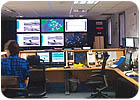
Monitoring of the IP-base security video system at Luton Airport is primarily at the control centre but networking allows live video at myriad locations, as necessary.
A potential, more effective mix of new technologies, personnel and procedures are, to many CEOs and chief security officers, found in the Petri dish of airport security.
Since the spate of airplane hijackings in the late 1960s, airport security executives have faced an escalating number of threats, more serious and complex over the years. At the same time, security efforts must still contend with the business demands of throughput, customer service and convenience.
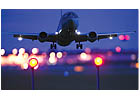
Ultimate business challenge
Two areas of current interest are emerging security video, especially evolving IP, and screening of personnel and baggage.London’s Luton Airport, for example, has phased in a new IP-based security video system that’s become one of the largest single-site IP systems in the United Kingdom. Installed by system integrator Intruder International using IndigoVision IP Video (Haverhill, Mass.) technology, the project demonstrates how IP can transform the security surveillance and operational effectiveness of a complex operation such as an international airport.
Like many enterprises, Luton started with analog video via co-axial cable to matrix switchers and low frame rate time-lapse recording. Some outlying areas were not covered due to the expense.
New cameras came first to the Airport Operations Centre; the tower’s remote location dictated an IP-based solution and piggybacking onto the existing IP network. This initial installation provided two things, a solution to the Operations Centre monitoring needs and an opportunity to trial IP video first hand.
Personal computers running IndigoVision’s Control Center software were then added to the network allowing the ops controllers to monitor aircraft movement video locally. These users, located anywhere on the network and not tied to existing analog monitoring stations, can control, administer, record, view and playback live video and audio over IP.
Following the successful trial, airport executives chose IP as the platform for expansion. New cameras are a mix of traditional analog units, for both internal and outdoor applications. Each camera connects to a transmitter/receiver module which converted the analog feed to digital video which transmitted over the existing 1 Gbit LAN/WAN infrastructure. The transmitter/receiver modules also transmitted control data allowing remote PTZ control.
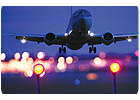
With IP as the security platform, baggage claim can be viewed but camera configurations can easily change to accommodate long-term changes in traffic patterns.
Live video at multiple locations
The majority of operations are monitored from the Network Operations Centre. Here images from any of the 250 plus cameras can display on a large plasma video wall along with other important information. Images stream as high definition digital video in real-time at 25 frames a second. Using advanced network protocols and the vendor’s multicast capabilities, it’s possible to view the live video at multiple locations with no incremental impact on the network.Locations covered include:
- Public safety, security and anti-terrorism operations.
- Air traffic control – monitoring runways, taxiways and aprons.
- Baggage handling – to check for lost or left luggage and carousel operation.
- Customs and excise.
- Cargo sheds, airside gates and perimeter monitoring.
- Retail and catering operations.
- Car parks and car hire desks – viewed by both security and the hire companies for staff protection and monitoring customer check-in queues.
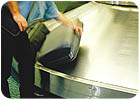
New personnel screening systems handle privacy concerns of passengers or employees. An option to AS&E’s SmartCheck can show a filtered image that presents only an outline of the scanned individual and quickly and reliably outlines any potential threats on the body.
Redundancy and scalability
One of the many advantages of video-over-IP is the ability, in the event of an emergency, to transfer control and monitoring capability to any other point on the corporate network both on site and even at another of the Group’s airports such as Cardiff or Belfast. New cameras can be added seamlessly with minimum overhead and cost.Initially all digital images from key cameras were converted back to analog and recorded on existing recorders. The next project phase: recording all digital video streams directly from the network in real-time using Network Video Recorders, each one mirrored to provide redundancy. This provided high quality, 25 frames a second recording and playback 24 hours a day, every day.
Beyond security video, another security process – personnel, baggage, cargo and package screening – may seem intrinsic to airports. But recent technology advances, ranging from privacy protection and multi-item detection to integration with ticketing, seem to point to enterprise uses beyond airports.
In screening, accuracy is crucial but so is the need to detect a diversity of objects while respecting passenger or employee privacy concerns.
Privacy filtering
For instance, Billerica, Mass.-based AS&E’s SmartCheck screens for contraband and threats hidden under a person’s clothing, simultaneously detecting both metallic and non-metallic objects, such as guns and knives, plastic explosives, composite weapons, drugs and other hidden threats and contraband. And its photo-like Z Backscatter image gives the operator an easy-to-read display of where the threat or contraband is hidden. An optional privacy filter protects the privacy of screened persons and still effectively displays threats.
The filtered image presents only an outline of the scanned individual and quickly and reliably outlines any potential threats on the body, all while ensuring the person’s privacy, according to Joe Reiss of AS&E.
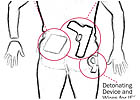
Package screening
Another example, the Rapiscan (Hawthorne, Calif.) Secure 1000 is a non-intrusive personnel screening system that detects metallic and nonmetallic objects concealed under a person’s clothing. As an alternative to intrusive pat-down searches, the unit alarms on conventional metal weapons, ceramic knives, explosives, illegal drugs, precious metals, cameras, recording devices and other contraband or security threats.Rapiscan’s line also includes systems aimed at enterprise mailrooms as well as airports. The 520S parcel inspection system has large lockable castors and fold-up conveyors, combined with a narrow overall width of 734mm (28.9inches), for space constrained environments. It can be wheeled through standard size doorways.
Advances are also integrating explosives detection within other business systems. Last month, Cubic Corporation and GE Security introduced the world’s first automatic public transit ticket vending machine with integrated early warning explosives detection capability. The new system represents the first component of the companies’ joint vision for the integration of real world, technology-enabled security solutions into a wide range of automatic fare collection “touch points.”
Such integration may help speed the acceptance of personnel screening and explosives detection into more typical enterprise access points ranging from door access control readers to visitor management.
Looking for a reprint of this article?
From high-res PDFs to custom plaques, order your copy today!





